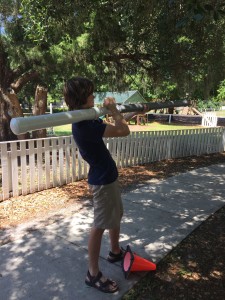Tennisball Air Cannon
Hey there! At the end of the 2014-15 school year, right before summer break I finished my physics project. I took applied physics. One of the focuses of applied physics are hands on activities and experimentation. This project was designed to test the effects of different weighted projectiles. The air tank portion of the air cannon was built from schedule 40 PVC and the barrel was made from grey electrical conduit. The conduit had the perfect interior diameter for a standard tennis ball. For each test, the cannon was pressurized to 90 psi, set at a 45 degree angle, loaded, and fired. The only thing that changed was the weight of the projectile. The tennis ball was slit open and lead fishing weights were stuffed into it. I expected the graph of the distance to look like a bell curve with the lightest and the heaviest projectiles going the shortest distance. My results were totally different than what I expected. During my experiment I concluded that for this air cannon, the heavier the tennis ball the farther it would fly. This was quite contrary to the math that stated that the heavier the ball the slower it would go. I think though that if I would have been able to keep increasing the weight of the projectile it would have eventually slowed down. We have a very long driveway on the side of our school, the driveway is about 200m long. The cannon, loaded with a projectile weighing about 500g and pressurized was fired about halfway down the driveway, and it went so far then the projectile was lost in the woods. The tests ended there due to the fact that were were out of fishing weights. I estimate that tennis ball traveled at least 100m. 500g traveling ~40m/s comes out to 400 joules of energy, impressive! I really loved building and testing this cannon, and it was great to be able to do it as a school project. One thing that I learned from this is that theory and practice really can differ quite a bit.
-Ben
Pictures below:




